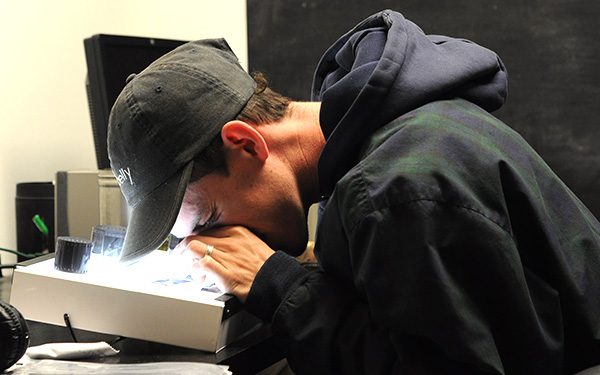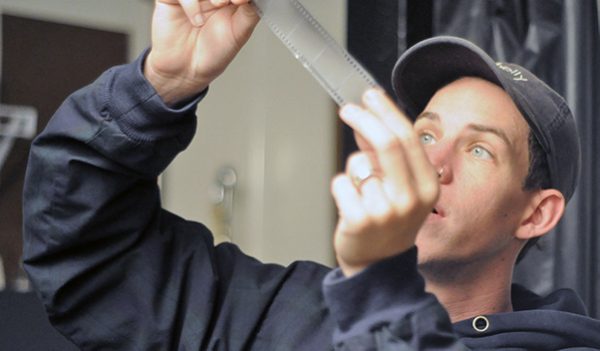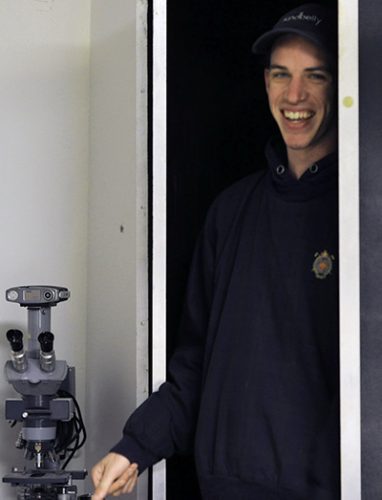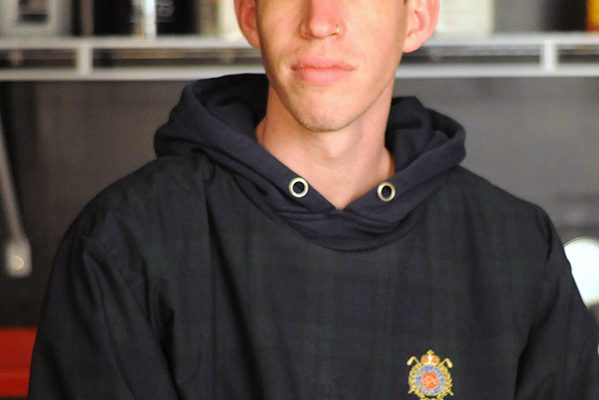
A new public darkroom for Midlands photographers is built on one photographer’s love for film in the digital age. Richard Voltz says “I probably would have cried” if he’d had access to a 24-hour darkroom years ago.
By Hannah Slater
May 5, 2018
Because photographer Richard Voltz has a love affair with film, Columbia photographers now can explore the same joy Voltz finds in darkrooms and chemicals far from the digital world.
Voltz is the force behind the creation of the community darkroom at Tapp’s Art Center, which opened March 1.
“I just wanted to give people the means that I never had,” Voltz says. “I mean if someone had told me that I could have 24-hour access to a darkroom, I probably would have cried.”
Voltz almost always has a camera in-hand, a photographer on a mission to document the world around him.
“I just love the developing process. There’s something special about documenting something and watching it come to life in such a tangible way,” Voltz says.
Now 25, Voltz says he became interested in photography when his sisters said they wanted good cameras and he got one too. At first he just shot for himself, but says that while attending Socastee High School in Myrtle Beach he was asked to do some work for the school’s magazine, where he then realized he could tell visual stories the way he wanted to.

Voltz remembers schools as about the only places where someone could get darkroom access without building their own.
When he couldn’t get access to school darkrooms, he says, “I used to develop film in my parents’ bathroom with a little tray in-between my legs, and I was like, I can’t continue to do this.”
Voltz’s friends say he is one of those people with the energy to conquer any task he sets his mind to.
“He’s very weird, but in the best way possible,” said Dani Thorner, who met Voltz while participating in an art collective. “He’s a wacky art boy, so I don’t think any of us were surprised when he decided to undertake the community darkroom.”
USC photography professor Gordon Humphries donated supplies and helped Voltz find materials and equipment, including an old darkroom revolving door that can cost $2,500 or more new.
“I’ve got a lot of respect for him, especially to be doing what he’s doing at this age. He’s really just very driven, and that’s not necessarily a trait that you find in people his age,” said Humphries, who never taught Voltz but knew of Voltz’s passion for film.
Zoe Hedquist, who worked with Voltz to create the darkroom and will manage it, said Voltz is a motivator who constantly pushes her to reach her goals.
“I love working with Richard. He’s super hardworking,” Hedquist said. “He’s always been really hardcore into photography, and he’s part of the reason that I decided to pursue it.”
Columbia Voice sat down with Voltz to learn more about his motivations for creating the darkroom. This excerpt has been edited for length and clarity. (Listen to the entire interview.)
Links
|
Why did you first get involved with photography?
I get like really into little things, and that being one of them. … I just like to take pictures and document things. Because like, even when I was in high school, they wanted me to do a bunch of stuff for the magazine there. And I was like, you know, that’s not my thing, I just want to shoot for me kind of. But once I like putting my stuff out there, I was like, oh well, this is nice, like I get to kinda tell a story in my own way. …
I love, like, analog things, so it was amazing to just be able to work and do, like, edit with my hands, basically. Which sounds like a really simple concept, but like, you know, it’s the digital age so people don’t really get to experience that a lot I guess? …
So how did you then, later on, get involved with Tapp’s? …
I left for two years and did a bunch of wedding photography and stuff in Myrtle Beach and kind of worked on my own career when I got out of school. So when I came back up here, Sean, spacehall partner, I was telling him about how everything I tried in Myrtle Beach failed. Like, you know, galleries, darkroom, like any arts thing, you know, they just, they weren’t having it. Which, understandable, it doesn’t fit that demographic of tourists. … But basically he was like, yeah, like you know, let’s make a space for people to work. So we pitched it to Tapp’s. They loved it. I mean, you know, because this is an arts building. It’s meant for things like this. …
So what kind of obstacles did you kind of have to overcome to create the darkroom?
Oh man. A lot. I’m not a carpenter. I’m not a plumber. I’m not necessarily an electrician. I don’t have much building experience. A lot of tearing down experience. I’m really good at tearing walls down, that’s fun.

But just about everything was a hiccup. And I don’t mean that in a bad way, because it was a learning experience, definitely. You know, this stuff was donated to us, it was a lot of stuff that we had to clean up, it was a lot of things that we had to double check. … And it’s like yeah, you know, I work with film and stuff, but that’s a whole different beast. …
Creatively, what is your process for taking photos and then later developing them? …
So recently what I’ve been doing is grabbing a roll in the morning, just sticking my hand in there. It’s like a raffle. And coming in here and developing and just like seeing what comes up, which is like, it’s a beautiful process. It’s so worthwhile for me. …
So in regards to the darkroom itself, what does it mean to you personally?
A lot. … For a while, I worked out of bathrooms, you know, tried to put blankets over the windows in my rooms to develop and to try to have a dark room. That’s what got me so motivated to do something like this, because I didn’t have the means to do what I wanted to do. …
I didn’t think about giving as much as I do now, especially with a place like this. … Like I want to get involved, I want to go to schools and, you know, teach kids how to do cyanotypes and stuff like that. But it’s hard to put into words what it means. …

